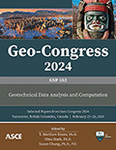MPM Coseismic Slope Runout Prediction Using the Intergranular Strain Anisotropy Hypoplastic Model
Publication: Geo-Congress 2024
ABSTRACT
The material point method (MPM) is an advanced particle-based numerical tool capable of modeling large deformations. However, its abilities to predict seismic site response, ground failure initiation, and post-failure consequences, including undrained conditions, have not been fully realized. This research aims to use recent MPM developments to simulate earthquake-triggered slope failures. As a novelty, an advanced constitutive model such as the intergranular strain anisotropy hypoplastic model is implemented in an effective-stress undrained MPM framework to simulate the hydromechanical response of dense and loose sand. First, an MPM simulation of a level-ground sand column is used to understand the system-level undrained response under simple sinusoidal excitation. Loose sand tends to liquefy under an increase in pore pressure, while dense sand exhibits a decrease in pore pressure. Second, a small-scale slope geometry is adopted whereby the runout investigation is conducted using void ratios ranging from 0.45 to 0.95. The framework shows promising system-level results, needing further validation using centrifuge experiments.
Get full access to this article
View all available purchase options and get full access to this chapter.
REFERENCES
Al-Kafaji, I. K. J. 2013. Formulation of a Dynamic Material Point Method (MPM) for Geomechanical Problems. PhD thesis, Universitat Stuttgart.
Alsardi, A., and Yerro, A. 2021. Runout modeling of earthquake-triggered landslides with the material point method. In IFCEE 2021 (pp. 21–31).
Alsardi, A., and Yerro, A. 2023. Coseismic site response and slope instability using periodic boundary conditions in the material point method. Journal of Rock Mechanics and Geotechnical Engineering, 15(3), pp.641–658.
Alsardi, A., Copana, J., and Yerro, A. 2021. Modelling earthquake-triggered landslide runout with the material point method. Proceedings of the Institution of Civil Engineers-Geotechnical Engineering, 174(5), pp.563–576.
Bozorgnia, Y., Abrahamson, N. A., and Atik, L. A. 2014. NGA-West2 research project. Earthquake Spectra, 30(3): 973–987.
Bray, J. D., Macedo, J., and Travasarou, T. 2018. Simplified procedure for estimating seismic slope displacements for subduction zone earthquakes. Journal of Geotechnical and Geoenvironmental Engineering, 144(3), p.04017124.
Dafalias, Y. F., and Manzari, M. T. 2004. Simple plasticity sand model accounting for fabric change effects. Journal of Engineering mechanics, 130(6), pp.622–634.
Duque, J., Yang, M., Fuentes, W., Mašín, D., and Taiebat, M. 2021. Characteristic limitations of advanced plasticity and hypoplasticity models for cyclic loading of sands. Acta Geotechnica, pp.1–23.
Feng, K., Wang, G., Huang, D., and Jin, F. 2021. Material point method for large-deformation modeling of coseismic landslide and liquefaction-induced dam failure. Soil Dynamics and Earthquake Engineering, 150, p.106907.
Fuentes, W., and Triantafyllidis, T. 2015. ISA model: a constitutive model for soils with yield surface in the intergranular strain space. International Journal for Numerical and Analytical Methods in Geomechanics, 39(11), pp.1235–1254.
Fuentes, W., Mercado, V., and Lascarro, C. 2018. Evaluation of the ISA-hypoplasticity constitutive model for the LEAP-2017 project. In Geotechnical Earthquake Engineering and Soil Dynamics V: Numerical Modeling and Soil Structure Interaction (pp. 165–173). Reston, VA: American Society of Civil Engineers.
Fuentes, W., Wichtmann, T., Gil, M., and Lascarro, C. 2020. ISA-Hypoplasticity accounting for cyclic mobility effects for liquefaction analysis. Acta Geotechnica, 15, pp.1513–1531.
Giridharan, S., Gowda, S., Stolle, D. F., and Moormann, C. 2020. Comparison of ubcsand and hypoplastic soil model predictions using the material point method. Soils and Foundations, 60(4), pp.989–1000.
Kohler, M., Stoecklin, A., and Puzrin, A. M. 2022. A MPM framework for large-deformation seismic response analysis. Canadian Geotechnical Journal, 59(6), pp.1046–1060.
Kularathna, S., Liang, W., Zhao, T., Chandra, B., Zhao, J., and Soga, K. 2021. A semi‐implicit material point method based on fractional‐step method for saturated soil. International Journal for Numerical and Analytical Methods in Geomechanics, 45(10), pp.1405–1436.
Niemunis, A. 2008. Incremental Driver User’s manual. Available from https://soilmodels.com/idriver/.
Poblete, M., Fuentes, W., and Triantafyllidis, T. 2016. On the simulation of multidimensional cyclic loading with intergranular strain. Acta Geotechnica, 11(6), pp.1263–1285.
Sulsky, D., Chen, Z., and Schreyer, H. L. 1994. A particle method for history-dependent materials. Computer methods in applied mechanics and engineering, 118(1-2), pp.179–196.
Von Wolffersdorff, P. A. 1996. A hypoplastic relation for granular materials with a predefined limit state surface. Mechanics of Cohesive‐frictional Materials: An International Journal on Experiments, Modelling and Computation of Materials and Structures, 1(3), pp.251–271.
Wichtmann, T., Fuentes, W., and Triantafyllidis, T. 2019. Inspection of three sophisticated constitutive models based on monotonic and cyclic tests on fine sand: Hypoplasticity vs. Sanisand vs. ISA. Soil Dynamics and Earthquake Engineering, 124, pp.172–183.
Information & Authors
Information
Published In
History
Published online: Feb 22, 2024
ASCE Technical Topics:
- Analysis (by type)
- Anisotropy
- Business management
- Continuum mechanics
- Decision making
- Decision support systems
- Deformation (mechanics)
- Engineering fundamentals
- Engineering mechanics
- Failure analysis
- Geomechanics
- Geotechnical engineering
- Material mechanics
- Materials engineering
- Methodology (by type)
- Models (by type)
- Numerical methods
- Numerical models
- Practice and Profession
- Slopes
- Soil dynamics
- Soil mechanics
- Soil pressure
- Solid mechanics
- Strain
- Structural mechanics
Authors
Metrics & Citations
Metrics
Citations
Download citation
If you have the appropriate software installed, you can download article citation data to the citation manager of your choice. Simply select your manager software from the list below and click Download.
